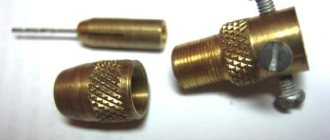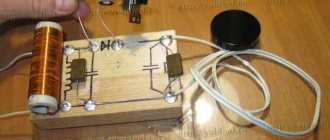If you have lost a ring, a key, a screwdriver... and you know the approximate location of the loss, then do not despair! You can assemble a metal detector with your own hands or ask a radio amateur you know to assemble a simple metal detector with your own hands
.
Below is a diagram of an easy-to-make and time-tested metal detector, which (with certain skills) can be made in one day. The simplicity of the described metal detector is that it is assembled on just one very common chip K561LA7 (CD4011BE)
. Setup is also simple and does not require expensive measuring instruments. To configure the generators, an oscilloscope or frequency meter is sufficient. If everything is done without errors and from serviceable elements, then these devices will not be needed.
Sensitivity of this metal detector:
a metal lid from a jar
up to 20 cm, a cell phone up to 15 cm, a Krona battery up to 10 cm, a 5 ruble coin up to 8 cm
.
At this distance the tone of the oscillator in the headphones barely changes; at a closer distance the tone increases. The larger the metal area, the greater the detection distance. Distinguishes between diamagnetic materials and ferromagnetic materials.
For making a metal detector
we will need:
- Chip K561LA7 (or K561LE5, analogue of CD4011);
- Transistor - low-power low-frequency, for example - KT315, KT312, KT3102, analogues: BC546, BC945, 2SC639, 2SC1815, etc.);
- Diode - any low-power one, for example - kd522B, kd105, kd106, analogues: in4148, in4001, etc.;
- Variable resistor - 3 pcs (1 kOhm, 5 kOhm, 20 kOhm with a switch or a separate switch);
- Fixed resistor - 5 pcs (22 Ohm, 4.7 kOhm, 1.0 kOhm, 10 kOhm, 470 kOhm);
- Ceramic, or even better, mica capacitors - 5 pcs: 1000 pF -3 pcs, 22 nF -2 pcs, 300 pf);
- Electrolytic capacitor (100.0 uF x 16V) - 1 piece;
- Wire PEL, PEV, PETV, etc., with a diameter of 0.4-0.7 mm;
- Low impedance headphones (from the player);
- Battery 9V.
Metal detector circuit
Appearance of the metal detector board
In the case from an old pocket radio (you can use the case from a soap dish, from a shoe-cleaning sponge, or in the case from an electrical junction box.
Attention! To eliminate interference and the influence of human hands when touching the regulators, the housings of variable resistors must be connected to the minus of the board.
If the metal detector circuit is properly soldered, the elements are in good working order and have the correct values, and the search coil is properly made, the device operates without problems. If, when you first turn on the headphones, you do not hear a squeak or change in frequency when adjusting the “FREQUENCY” regulator, then you need to select a resistor (10 kOhm) in series with the regulator and/or a capacitor in this generator (300 pF). Thus, we make the frequencies of the reference and search generators the same.
When the generator is excited, whistling, hissing, and distortion appear, solder a 1000 pF capacitor (1H0 aka 102) to the pin. 6 chips per case.
Using an oscilloscope or frequency meter, look at the signal frequencies at pins 5 and 6 of the K561LA7. Achieve their equality using the above-described adjustment method. The operating frequency of the generators itself can vary from 80 to 200 kHz.
A protective diode (any low-power one) is needed to prevent damage to the microcircuit when the battery is turned on by mistake (which often happens:).
Making a metal detector coil
The coils are wound on a mandrel with a diameter of 15-25 cm (for example, a bucket or on a shuttle made of thick wire or plywood - the smaller the diameter, the less sensitivity, but the greater the selectivity of small metals). Choose for what purpose you need it.
A wire is used in varnish insulation PEL, PEV, PETV..., with a diameter of 0.4 - 0.7 mm (well suited for old color TVs with a kinescope demagnetization loop or deflection system) and contains about 100 turns (you can wind from 80 to 120 turns ). Wrap the wire tightly with electrical tape.
Then we wrap the coil over the electrical tape with a strip of foil, leaving 2-3 cm of the unwrapped area. Foil can be taken from some types of cables or, as a last resort, cut foil from a chocolate bar into strips 2 cm wide











